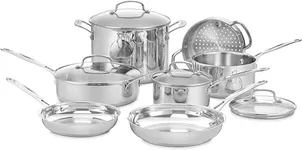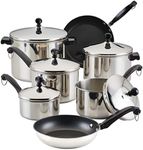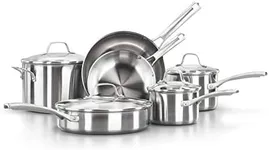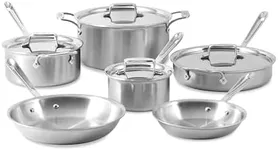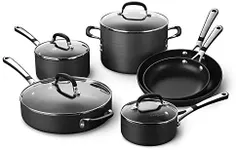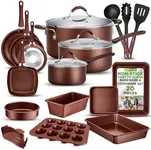Buying Guide for the Best Pots and Pans Sets
Choosing the right pots and pans set can significantly enhance your cooking experience. The right set will not only make cooking more enjoyable but also ensure that your food is cooked evenly and efficiently. When selecting a pots and pans set, consider the material, size, weight, and compatibility with your stove. Each of these factors can impact the performance and durability of your cookware. Here are some key specifications to consider when choosing a pots and pans set.MaterialThe material of your pots and pans affects heat conductivity, durability, and ease of cleaning. Common materials include stainless steel, non-stick, cast iron, and copper. Stainless steel is durable and resistant to rust but may not conduct heat as well as other materials. Non-stick pans are easy to clean and great for low-fat cooking but can be prone to scratching. Cast iron retains heat well and is excellent for searing, but it is heavy and requires special care. Copper offers superior heat conductivity but can be expensive and requires regular polishing. Choose a material based on your cooking habits and maintenance preferences.
Size and Number of PiecesPots and pans sets come in various sizes and with different numbers of pieces. A basic set might include a few essential pieces like a frying pan, a saucepan, and a stockpot, while more comprehensive sets can include additional items like sauté pans, steamer inserts, and more. Consider the size of your household and the types of dishes you frequently prepare. If you cook for a large family or enjoy making a variety of dishes, a larger set with more pieces might be beneficial. For smaller households or simpler cooking needs, a basic set may suffice.
WeightThe weight of the pots and pans can affect how easy they are to handle. Heavier pots and pans, like those made from cast iron, are excellent for even heat distribution and retention but can be cumbersome to lift and move. Lighter options, such as aluminum or non-stick pans, are easier to handle but may not offer the same level of heat retention. Consider your strength and comfort level when choosing the weight of your cookware. If you prefer something easy to maneuver, opt for lighter materials.
Stove CompatibilityNot all pots and pans are compatible with every type of stove. Some materials, like stainless steel and cast iron, work well on all stove types, including induction. Others, like certain non-stick or aluminum pans, may not be suitable for induction cooktops. Check the manufacturer's specifications to ensure the set you choose is compatible with your stove. If you have an induction cooktop, make sure the cookware is induction-ready.
Oven SafetyIf you plan to use your pots and pans in the oven, it's important to check their oven safety rating. Some materials and handles can withstand high temperatures, while others cannot. Stainless steel and cast iron are generally oven-safe, but non-stick pans may have temperature limits. Consider the types of dishes you like to prepare and whether you need your cookware to transition from stovetop to oven. Choose a set that meets your oven safety requirements.
Ease of CleaningCleaning your pots and pans can be a significant factor in your overall satisfaction with the set. Non-stick pans are generally the easiest to clean, but they require gentle handling to avoid scratching. Stainless steel can be more challenging to clean if food sticks, but it is dishwasher safe and can handle more abrasive cleaning tools. Cast iron requires special care to maintain its seasoning. Consider how much time and effort you are willing to invest in cleaning your cookware and choose a set that aligns with your preferences.
